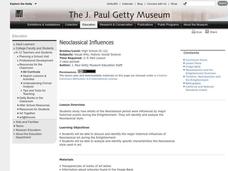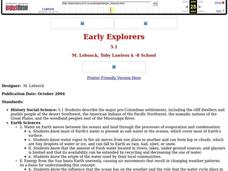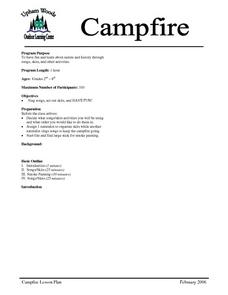Curated OER
Neoclassical Influences
Students analyze neoclassical art. In this art history lesson, students listen to their instructor present a lecture regarding the details of the art produced during the Enlightenment.
Curated OER
Early Explorers
Fifth graders study early explorers. In this World history lesson, 5th graders draw an outline of a map labeling each part, build geographical features out of dough, and paint each of the land and water features.
Curated OER
Cloud in the Classroom
Students watch a video about wild stallions and conduct research about wild horses and wildlife photography. Students explore the relationships between animals and humans and conduct Internet research about the treatment of wild horses...
Curated OER
America's Heartland
Fifth graders investigate imports and exports to discover its importance to America as a world power. In this Imports and exports lesson, 5th graders discuss how climate and natural resources aid a country in becoming a world...
Curated OER
Building Straw Towers
Students apply their knowledge of technology to help them build. For this science and technology lesson, students build straw towers and investigate the strength and form of the structure. They analyze the best design the make the...
Curated OER
Atlatl (Native Americans)
Learners discover what an atlatl is and how to use it. In this Native American lesson, students discuss the history of the Native American atlatl and practice throwing with it. Learners will analyze the effects of the atlatl in terms of...
Curated OER
Reporting Live From...
Students examine the many disasters in West Virginia. In this US history lesson, students write about and give an oral presentation of one of the disasters as if they were reporters.
Curated OER
Who Writes History?
Students examine why certain historical figures get credit for their accomplishments while others are forgotten. They read and discuss two informational handouts, discuss why people remember Columbus even if he was not the first person...
Curated OER
Campfire
Students have fun and investigate about the nature and history through songs, skits, and other activities. They sing songs, and act out skits. Students decide what songs or skits that they are going to sing. They sit around a campfire...
Curated OER
Salmon and Steelhead Life Stories Web Search
Students conduct an Internet investigation to discover the natural history of local salmon and/or steelhead. They then write a story that describes the life of a salmon or steelhead from the local creek, including a description of each...
Fluence Learning
Writing About Literature: What Is Happiness?
Jack London's heart for adventure has come to define the spirit of America and its frontier. Selected passages from the foreword The Cruise of the Snark take eighth graders through London's construction and voyage of his ship before...
Indian Land Tenure Foundation
A Sense of Belonging
In order to understand how the land changes over time because of the people who live there, learners interview an elderly person about the past. Children ask an older family member to describe what the local area was like when they were...
Lee & Low Books
Classroom Guide for Sacred Mountain: Everest
The most famous climbers of Mount Everest could never have made it to the summit without the assistance of the local Sherpa. Christine Taylor-Butler's nonfiction children's book Sacred Mountain: Everest is the focus of an extensive...
American Museum of Natural History
Journey to the Stars
Fifteen detailed pictures and informative captions delve deep into the exploration of stars—their life cycle and importance in the universe.
Curated OER
How Do New Species Form?
Students read an article by Niles Eldridge about species and the environment and break into small groups to discuss it. They write essays noting strengths and weaknesses of punctuated equilibrium and gradualism, or other topics listed.
Curated OER
Fahrenheit vs Celsius
Learners construct a thermometer and convert Fahrenheit temperature into Celsius temperature. In small groups, they construct a thermometer, write a paragraph describing how to make a thermometer, and convert temperatures.
Curated OER
Modeling the Process of Mining Silicon Through a Single Displacement/Redox Reaction
Students study silicon and where it comes from. In this solar mining lesson plan students complete an Internet search of mining and a lab activity.
Curated OER
Knocked Out by Trout
Students work in pairs and read an article about the pacific tree frogs being knocked out by the nonnative trout. In this invasive species instructional activity, students create a graphic organizer to record their findings. Once the...
Curated OER
Plants and Animals of Great Bay Animals and Plants of the Estuary
Students participate in a webquest about the plants and animals that inhabit an estuary. They role play as environmentalists researching this habitat and present the results of their research in a creative way.
Curated OER
The Flame and the Atom:
Students investigate the structure of atoms. Students read information about the Rutherford model, the Bohr model, and the Quantum Mechanical model examining each for its scientific validity. They watch a PowerPoint presentation of alpha...
Curated OER
Are You One of Us?
Students investigate how scientists sort and classify organisms. In this sorting and classifying lesson, students examine what systematics are as tools that scientists use. They examine images of invertebrates and sort them while stating...
Curated OER
Rocks in our Backyard
High schoolers examine igneous and sedimentary rocks. They observe and identify geological formations in their community, analyze igneous and sedimentary geological layers using a geological map, and use GPS to locate geological formations.
Curated OER
Raptor Force
Students observe a video about pilots, their desired traits, and explore the similarities between a bird and an airplane. Using paper, wood or foam, they design create an aircraft to be flown in a competition to see which plane will fly...
Curated OER
Wildlife Study Comparison
Students compare/contrast two studies that examine the effects of environmental contaminants on animals. They read an article, identify the components of a research study, summarize the article, and complete a matrix.

























